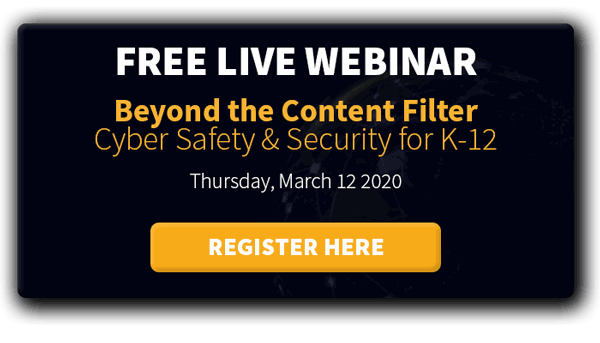Cyber Safety In Schools: Why It’s Time To Think Beyond Your Content Filter
Student cyber safety issues have changed since content filters were all you needed
Students are using the internet more now than ever before. They’re using online resources to do their homework. But, they’re also using the internet in ways that the Congress never thought of in 2000 when the Children’s Internet Protection Act (CIPA) made its way into law.
Today, students are using the internet to socialize and communicate with friends and family. A student’s digital and physical have converged, oftentimes with positive outcomes. But when the outcomes aren’t positive it’s often because we aren’t protecting our children as well as we should. Given today’s environment, the content filters school districts have relied on for cybersecurity aren’t effective to ensure comprehensive cyber safety in schools.
Content Filters: The School Cyber Safety Workhorse
Virtually all schools use a web content filter. When CIPA took effect in 2000, it put some restrictions on schools and libraries that participate in the E-rate program. E-rate is an FCC program that offers discounts to eligible schools and libraries to help fund telecommunications and information services.
CIPA requires school districts to have technology that blocks or filters students’ internet access to inappropriate content before the districts can participate in the E-rate program. As a result, schools generally maintain a content filter to meet that requirement.
The cost for content filtering technology varies widely, but school districts find that maintaining it is costly. Larger school systems often pay $100-150,000 per year to maintain a filter.
{FREE WEBINAR} BEYOND THE CONTENT FILTER: LEARN MORE & REGISTER >>
Pros and Cons of Content Filters for Cyber Safety in Schools
Content filters do serve a purpose. They can work through a browser to identify inappropriate content and block it before it is displayed on the screen. However, content filters do have pros and cons.
Pros of Content Filters
A compelling reason to use content filters is to stay in compliance with CIPA and the Children’s Online Privacy Protection Act of 1998 (COPPA). With content filters, students can’t spend time surfing the internet to avoid classwork, and they can’t view inappropriate content whether they’ve accessed it purposely or by accident.
Some filters can limit access on a student’s home computer, and/or allow administrators to set filters based on specific groups. Some solutions can scan encrypted data using SSL connections.
Cons of Content Filters
Content filters are limited in a number of ways. They don’t comply with the Family Educational Rights and Privacy Act (FERPA) to provide student data privacy protection. Further, while filters can block inappropriate content, they can also block valid educational resources that students and teachers need to use. Content filters have a range of other limitations.
- Traditional content filters typically can’t police a school’s shared drives or email
- Content filters can’t protect against malware, phishing, ransomware, and other types of cyberattacks
- They can’t protect sensitive district and student data
- Content filters are usually restricted for use only on devices issued by schools
Given the evolving role of the internet in district schools, the limitations of content filters are becoming more of an issue than they ever have been in the past.
{FREE WEBINAR} BEYOND THE CONTENT FILTER: LEARN MORE & REGISTER >>
Your School’s Cyber Safety Landscape is Changing
In the early days of the internet, it’s possible that the biggest problem school districts faced was protecting children from exposure to harmful or explicit content. Today, your problem is much different. Cloud applications such as Google G Suite are changing the landscape.
There are many good reasons why your district might use G Suite. But, it has been touched by the law of unintended consequences. Think of it like pseudoephedrine. Most people use that drug to relieve sinus congestion, but some use it to make the illegal drug methamphetamine.
In the same way, students have found illicit ways to use G Suite. Students have started to use Google Docs as “chat rooms.” They can invite others to visit their document, share images and videos, create and delete text, and delete entire documents. The worst thing is that many of those “rooms” have become the site of cyberbullying.
Most content filters can’t monitor a Google Doc. As a result, you can’t easily detect when students use these files for harmful purposes such as bullying, self-harm discussions, or threats of violence. When students upload images and videos to shared drives, your content filter can’t block them. In many cases, you don’t have the ability to easily find and delete these files. If you do find one of these files, it’s often impossible to tell which students added inappropriate content to the file.
Cyber safety in schools is a big challenge. It’s time to look beyond your content filter to find the tools and technologies that will help you ensure cyber safety now and in the future. The answer isn’t to abandon advances like G Suite. Drug manufacturers haven’t stopped producing pseudoephedrine, but they have put controls on its sale.
Take steps to protect your school community from the law of unintended consequences today! Register for our free webinar to learn how Tim Miles and his IT team at Steamboat Springs School District are securing student and district data while monitoring for cyber safety issues in their schools.
The post Cyber Safety In Schools: Why It’s Time To Think Beyond Your Content Filter appeared first on ManagedMethods.
*** This is a Security Bloggers Network syndicated blog from ManagedMethods authored by Katie Fritchen. Read the original post at: https://managedmethods.com/blog/cyber-safety-in-schools/






